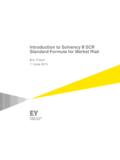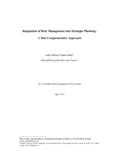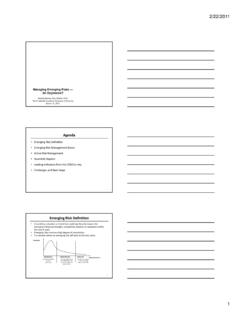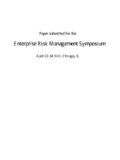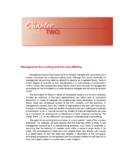Transcription of Decision Making Under Uncertain and Risky …
1 Decision Making Under Uncertain and Risky Situations K. Khalili Damghani . Department of Industrial Engineering, Faculty of Engineering, Islamic Azad University, Science & Research Branch, Tehran, Iran M. T. Taghavifard Faculty of Acounting & Management, Allameh Tabatabayee University, Tehran, Iran R. Tavakkoli Moghaddam Department of Industrial Engineering, College of Engineering, University of Tehran, Tehran, Iran Abstract. Decision Making is certainly the most important task of a manager and it is often a very difficult one. The domain of Decision analysis models falls between two extreme cases. This depends upon the degree of knowledge we have about the outcome of our actions.
2 One "pole" on this scale is deterministic. The opposite "pole" is pure uncertainty. Between these two extremes are problems Under risk. The main idea here is that for any given problem, the degree of certainty varies among managers depending upon how much knowledge each one has about the same problem. This reflects the recommendation of a different solution by each person. Probability is an instrument used to measure the likelihood of occurrence for an event. When probability is used to express uncertainty, the deterministic side has a probability of 1 (or zero), while the other end has a flat (all equally probable) probability.
3 This paper offers a Decision Making procedure for solving complex problems step by step. It presents the Decision -analysis process for both public and private Decision - Making , using different Decision criteria, different types of information, and information of varying quality. It describes the elements in the analysis of Decision alternatives and choices, as well as the goals and objectives that guide Decision - Making . The key issues related to a Decision -maker's preferences regarding alternatives, criteria for choice, and choice modes, together with the risk assessment tools are also presented. Keywords: Decision Making Under Risk, Risk Management, Decision Making Technique, Bayesian Approach, Risk Measuring Tool.
4 Corresponding Author;. Postal Address: No. 148, 134 Ave., 111 St., Tehranpars, Tehran, Iran. Tel: +98-09123980373. FAX: +982177868749. E-mail: 1 INTRODUCTION. Modeling for Decision Making involves two distinct parties, one is the Decision -maker and the other is the model-builder known as the analyst. The analyst is to assist the Decision -maker in his/her Decision - Making process. Therefore, the analyst must be equipped with more than a set of analytical methods. Specialists in model building are often tempted to study a problem, and then go off in isolation to develop an elaborate mathematical model for use by the manager ( , the Decision - maker).
5 Unfortunately the manager may not understand this model and may either use it blindly or reject it entirely. [1] The specialist may feel that the manager is too ignorant and unsophisticated to appreciate the model, while the manager may feel that the specialist lives in a dream world of unrealistic assumptions and irrelevant mathematical language. Such miscommunication can be avoided if the manager works with the specialist to develop first a simple model that provides a crude but understandable analysis. After the manager has built up confidence in this model, additional detail and sophistication can be added, perhaps progressively only a bit at a time.
6 This process requires an investment of time on the part of the manager and sincere interest on the part of the specialist in solving the manager's real problem, rather than in creating and trying to explain sophisticated models. This progressive model building is often referred to as the bootstrapping approach and is the most important factor in determining successful implementation of a Decision model. Moreover the bootstrapping approach simplifies otherwise the difficult task of model validating and verification processes. [2]. In deterministic models, a good Decision is judged by the outcome alone. However, in probabilistic models, the Decision - maker is concerned not only with the outcome value but also with the amount of risk each Decision carries.
7 As an example of deterministic versus probabilistic models, consider the past and the future. Nothing we can do can change the past, but everything we do influences and change the future, although the future has an element of uncertainty. Managers are captivated much more by shaping the future than the history of the past. [3]. Uncertainty is the fact of life and business. Probability is the guide for a "good" life and successful business. The concept of probability occupies an important place in the Decision - Making process, whether the problem is one faced in business, in government, in the social sciences, or just in one's own everyday personal life.
8 In very little Decision Making situations is perfect information - all the needed facts - available. Most decisions are made in the face of uncertainty. Probability enters into the process by playing the role of a substitute for certainty - a substitute for complete knowledge [4]. Probabilistic Modeling is largely based on application of statistics for probability assessment of uncontrollable events (or factors), as well as risk assessment of your Decision . The original idea of statistics was the collection of information about and for the State. The word statistics is not derived from any classical Greek or Latin roots, but from the Italian word for state.
9 Probability has a much longer history. Probability is derived from the verb to probe meaning to "find out" what is not too easily accessible or understandable. The word "proof" has the same origin that provides necessary details to understand what is claimed to be true. Probabilistic models are viewed as similar to that of a game; actions are based on expected outcomes. The center of interest moves from the deterministic to probabilistic models using subjective statistical techniques for estimation, testing, and predictions. In probabilistic modeling, risk means uncertainty for which the probability distribution is known.
10 Therefore risk assessment means a study to determine the outcomes of decisions along with their probabilities [4]. Decision -makers often face a severe lack of information. Probability assessment quantifies the information gap between what is known, and what needs to be known for an optimal Decision . The probabilistic models are used for protection against adverse uncertainty, and exploitation of propitious uncertainty. Difficulty in probability assessment arises from information that is scarce, vague, inconsistent, or incomplete. A statement such as "the probability of a power outage is between and " is more natural and realistic than their "exact" counterpart such as "the probability of a power outage is [5].
